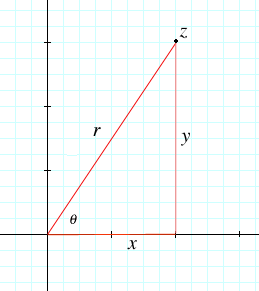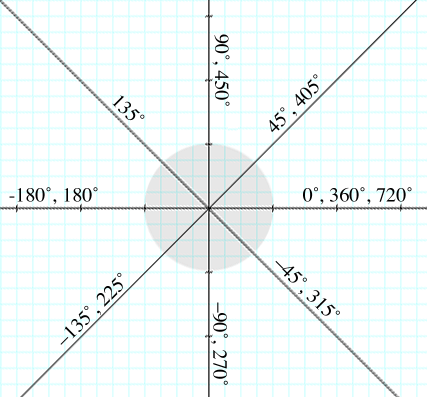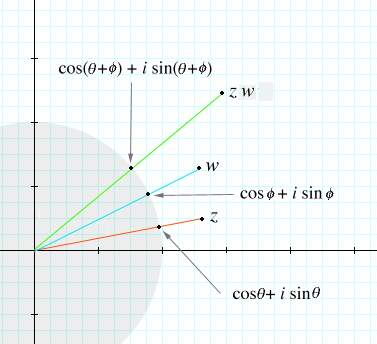 for the line from the origin to the point.
We’ve already called the distance r the absolute value |z| of z, and we saw how the
Pythagorean theorem gave relation between it and x and y:
for the line from the origin to the point.
We’ve already called the distance r the absolute value |z| of z, and we saw how the
Pythagorean theorem gave relation between it and x and y:
 This section assumes a knowledge of trigonometry. For information on trigonometry, see Dave’s Short Trig Course at
This section assumes a knowledge of trigonometry. For information on trigonometry, see Dave’s Short Trig Course at
http://www.clarku.edu/~djoyce/trig/

Polar coordinates will help us understand complex numbers geometrically. On the one hand, the usual rectangular coordinates
x and y specify a complex number z = x + yi by giving the distance
x right and the distance y up. On the other hand, polar coordinates specify the same point z by saying how
far r away from the origin 0, and the angle  for the line from the origin to the point.
We’ve already called the distance r the absolute value |z| of z, and we saw how the
Pythagorean theorem gave relation between it and x and y:
for the line from the origin to the point.
We’ve already called the distance r the absolute value |z| of z, and we saw how the
Pythagorean theorem gave relation between it and x and y:

Next, we need to deal with the angle  . We’ll follow the standard convention for specifying the angle
. We’ll follow the standard convention for specifying the angle
 . This convention takes the positive x-axis (our real axis) to be at angle 0°, the
positive y-axis (our imaginary axis) at angle 90°, the negative x-axis angle 180°, and the negative
y-axis at angle 270°. Also, 360° can be added or subtracted from any angle and the direction is not changes. So,
0°, 360°, 720°, and –360° all refer to the positive x-axis. Similarly, 270° and –90°
both refer to the negative y-axis. A 45° angle runs along the line y = x, up to the right.
And so forth.
. This convention takes the positive x-axis (our real axis) to be at angle 0°, the
positive y-axis (our imaginary axis) at angle 90°, the negative x-axis angle 180°, and the negative
y-axis at angle 270°. Also, 360° can be added or subtracted from any angle and the direction is not changes. So,
0°, 360°, 720°, and –360° all refer to the positive x-axis. Similarly, 270° and –90°
both refer to the negative y-axis. A 45° angle runs along the line y = x, up to the right.
And so forth.

A point z can be specified by either pair, the pair of rectangular coordinates, x and y, or the pair of polar
coordinates, r, which is |z|, and  , which is arg (z). Since either pair
determines the point,
, which is arg (z). Since either pair
determines the point,
 each pair should determine the other pair. There should be four equations, connecting them, and so there are. The Pythagorean
identity was mentioned above, but the others require trigonometry. From the same triangle we
used for the Pythagorean theorem, we find the following three relations:
each pair should determine the other pair. There should be four equations, connecting them, and so there are. The Pythagorean
identity was mentioned above, but the others require trigonometry. From the same triangle we
used for the Pythagorean theorem, we find the following three relations:
 = y/x, x = r cos
= y/x, x = r cos  , and
y = r sin
, and
y = r sin  .
.
Now, if we apply these relations to our complex number z = x + yi, then we get an alternate description for z
| z | = | x + iy |
| = | r cos  + i r sin + i r sin  | |
| = | r (cos  + i sin + i sin  ) ) | |
| = | |z| (cos  + i sin + i sin  ) ) |
Note that the complex number cos  + i sin
+ i sin  has absolute value 1 since cos2
has absolute value 1 since cos2 + sin2
+ sin2 equals 1 for any angle
equals 1 for any angle  . Thus, every complex number z is the
product of a real number |z| and a complex number cos
. Thus, every complex number z is the
product of a real number |z| and a complex number cos  + i sin
+ i sin  .
.

We’re almost to the point where we can prove the last unproved statement of the previous section on multiplication, namely,
that arg(zw) = arg(z) + arg(w). As above, we take arg(z) to be  , and now let arg(w) be
, and now let arg(w) be  . Then,
. Then,
 + i sin
+ i sin  )
)
 + i sin
+ i sin  )
)
We need to show that arg(zw) is  +
+  . In other words
. In other words
 +
+  ) + i sin
(
) + i sin
( +
+  ))
))
If we use the addition formulas for cosine and sine at one crucial point, we’ll have it. Recall from trigonometry these addition formulas:
 +
+  ) = cos
) = cos  cos
cos  – sin
– sin  sin
sin 
sin ( +
+  ) = cos
) = cos  sin
sin  + sin
+ sin  cos
cos  .
.
Now we’re ready to show arguments add in the product zw.
| zw | = | |z| (cos  + i sin + i sin  ) |w| (cos ) |w| (cos
 + i sin + i sin  ) ) |
| = | |zw| (cos  + i sin + i sin  ) (cos ) (cos  + i sin + i sin  ) ) | |
| = | |zw| ((cos  cos cos  – sin – sin  sin sin  ) + i(cos ) + i(cos  sin sin  + sin + sin  cos cos  )) ))
| |
| = | |zw| (cos ( + +  ) + i sin ( ) + i sin ( + +  )) ))
|
Thus, arg(zw) is  +
+  , as claimed.
, as claimed.